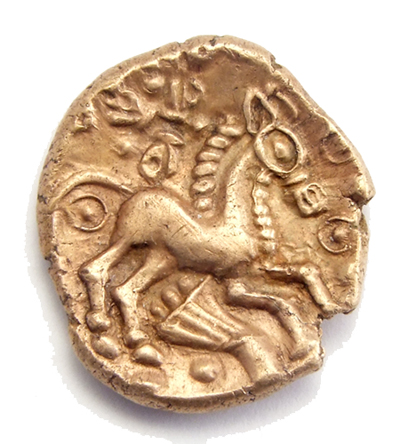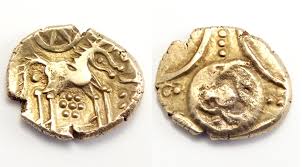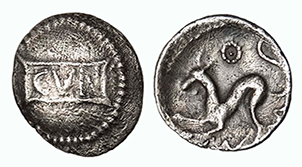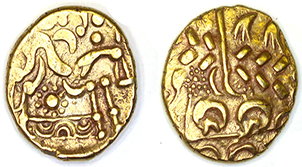




Trinovantes Gold Stater
Legacy of Celtic Coinage
Today, Celtic coins are highly prized by collectors and historians alike. They serve as a testament to the ingenuity and artistry of the Celtic tribes and their leaders. Many of these coins are housed in museums, while others continue to be unearthed by metal detectorists, shedding new light on the ancient past.
Celtic coinage is not merely a relic of history; it is a bridge to understanding the rich cultural tapestry of Britain's Celtic heritage.

Iceni Gold Stater
15 BC-20 AD
15 BC-20 AD
Catuvellauni Silver Unit
9-40 AD
9-40 AD

Corieltauvi Gold Stater
50-20 BC
50-20 BC
Author: Simon Ellis
Date Published: 30 December 2024
Date Published: 30 December 2024

Celtic Coinage in Britain: A Journey Through History
Celtic coinage in Britain represents a fascinating chapter in the history of ancient Europe, reflecting the cultural, political, and economic landscapes of the Celtic tribes that inhabited the region. These coins, minted between the late Iron Age and the Roman conquest, provide invaluable insights into the lives of the tribes, their notable leaders, and their connections with continental Europe.
Origins of Celtic Coinage in Britain
Before the adoption of coinage, the Celts in Britain operated primarily within a barter economy. Goods such as cattle, grain, and metal objects were exchanged directly. High-value trade relied on weighed metal objects like gold torcs and rings, which could serve as proto-currency. These items were portable and valuable, facilitating exchanges over long distances.
Celtic coinage in Britain was heavily influenced by trade and cultural interactions with mainland Europe. The earliest coins, dating from around 200 BCE, were modeled on the gold staters of Philip II of Macedon and later the Gaulish coins of the Aedui and other tribes. Initially, these coins were imported, but the British Celts soon began minting their own versions.
The designs of these coins evolved over time, showcasing artistic creativity and the influence of local beliefs. Early coins often featured abstract representations of chariots, horses, and stylized human faces, while later examples included more detailed depictions of leaders and diaties.
Key Celtic Tribes and Their Coinage
In Britain, several Celtic tribes issued their own coinage, often reflecting their distinct identities and political power. Below is an overview of the major tribes, along with their contributions to Celtic coinage:
The Iceni
Location: Modern-day Norfolk and Suffolk
Coinage: The Iceni were among the first tribes to mint their own coins, with designs that often featured stylized horses and enigmatic symbols. Their coins were made of gold and silver, reflecting the tribe's wealth and independence.
Historical Note: The Iceni are best known for Queen Boudica, though her revolt against Rome occurred after their peak coinage period.
The Trinovantes
Location: Essex and parts of Hertfordshire
Coinage: The Trinovantes were among the most prolific coin producers in Britain.
Coins under Addedomarus featured detailed horse motifs and inscriptions, marking a shift towards more personalized and symbolic designs. They traded extensively with the Romans, which influenced the sophistication of their coinage.
Historical Note: The Trinovantes played a significant role in the resistance to Caesar during his invasions of Britain.
The Catuvellauni
Location: Hertfordshire, Bedfordshire, and Buckinghamshire
Coinage: Tasciovanus issued coins featuring intricate designs of horses and inscriptions in Latin, indicating strong Roman influence.
His son Cunobeline, often referred to as the "King of the Britons," produced some of the most advanced Celtic coins. His coins bore Latin inscriptions such as "CUNO," demonstrating his claim to power and his connection with Rome.
Historical Note: Cunobeline was a pivotal figure in late Iron Age Britain.
The Dobunni
Location: Gloucestershire and surrounding areas
Coinage:The Dobunni were known for their gold and silver coins, often adorned with abstract patterns and motifs inspired by nature.
Their coins were used extensively in trade, indicating their economic prosperity.
Historical Note: The Dobunni were known for their peaceful interactions with Rome, which may explain the continuity of their coinage style.
The Atrebates
Location: Hampshire, Berkshire, and Sussex
Coinage: Commius, originally an ally of Julius Caesar, established a powerful kingdom in southern Britain. Coins of the Atrebates were richly decorated with imagery, including horses, wheat sheaves, and inscriptions. Verica's coins show advanced Roman influence, with inscriptions identifying him as "Rex," or king.
Historical Note: Verica, the last Atrebatic king, sought Roman support, which may have hastened the Roman invasion.
The Corieltauvi
Location: Lincolnshire and surrounding areas
Coinage:The Corieltauvi were prolific in producing coins, though many were inscribed with enigmatic symbols rather than names of rulers.Their coinage played a significant role in regional trade networks.
Historical Note: The Corieltauvi are known for their large hoards of coins, indicating their economic and ritual significance.
The Durotriges
Location: Dorset and parts of Wiltshire
Coinage:The Durotriges are known for their distinctive, heavily stylized coins. Their "Cranborne Chase" type coins are highly abstract, reducing earlier motifs to simple geometric shapes.
These coins represent a move away from continental influences, highlighting local innovation.
Historical Note: Their coinage is among the most localized, with little external influence compared to other tribes.
The Cantii
Location: Kent
Coinage:The Cantii were one of the first tribes to adopt coinage, given their proximity to continental Europe. Their coins often mirrored Gaulish designs, with detailed depictions of horses and chariots.
Historical Note: The Cantii were instrumental in facilitating trade between Britain and the Roman world.
The Brigantes
Location: Yorkshire and northern England
Coinage:The Brigantes, the largest tribe in Britain, were late adopters of coinage.Their coins were primarily bronze and featured simple designs, including animal motifs and abstract patterns.Coinage played a minor role in their economy, which remained largely barter-based.
Historical Note: The Brigantes' stronghold in the north limited their exposure to continental trade and Roman influence.
The Regni
Location: Sussex and southern England
Coinage:The Regni, closely associated with the Atrebates, issued coins with similar designs and inscriptions. Their coins often featured horses and rosettes, signifying power and prosperity. Inscriptions in Latin highlighted their connections with Rome.
Historical Note: The Regni were among the tribes that adapted quickly to Roman rule.
The Parisii
Location: East Yorkshire
Coinage:The Parisii minted distinctive coins with intricate patterns and animal depictions. Their designs were heavily influenced by continental Celtic art, reflecting their close ties to Gaul. Coins were typically small and made of base metals, suggesting limited use for trade.
Historical Note: The Parisii maintained strong cultural ties with their counterparts in Gaul, influencing their coinage.
Celtic Coinage: A Symbol of Power and Culture
Celtic coins were more than just currency; they were symbols of power, status, and identity. The use of inscriptions, often in Latin, reflected the growing influence of Rome, while the artistic designs revealed the tribes' cultural values and religious beliefs. Horses, a common motif, symbolized strength and prestige, while other designs drew from local myths and natural elements.
The End of Celtic Coinage
Celtic coinage began to decline following the Roman invasion in AD 43. The Romans introduced their own monetary system, which gradually replaced local coinage. However, the legacy of Celtic coins endures, offering modern archaeologists and historians a window into the dynamic and diverse world of ancient Britain.


